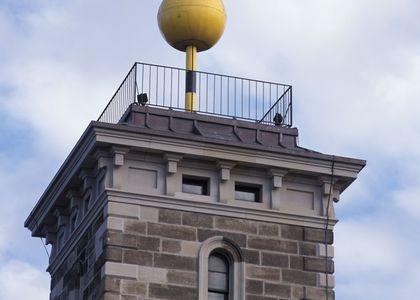To help you learn about the southern night sky, Sydney Observatory provides a guide and a sky map or chart each month. This month’s guide is presented by Melissa Hulbert, Sydney Observatory’s Site Programs Coordinator.
In the February sky guide, as well as showing us where to find the constellations Orion, Canis Major and Taurus, and the star clusters, Hyades and Pleiades, Melissa tells us the best times to see the planets Venus, Mars, Jupiter and Saturn.
Hear the Audio
You can subscribe to the podcast on iTunes or directly download this month’s guide to your favourite audio listening device.
See The Sky Chart
We provide a February 2019 night sky chart (PDF) which shows the stars, constellations and planets visible in the night sky from anywhere in Australia. To view PDF star charts you will need to download and install Adobe Acrobat Reader if it’s not on your computer already.
Read The Guide
Hello and welcome to the night sky for February. My name is Melissa Hulbert and I’m the Site Programs Coordinator at Sydney Observatory.
Before we start our night sky tour, make sure you download the February sky map.
Armed with your sky map and a small torch with some red cellophane covering it, find a nice dark place away from the glare of the street lights and make sure you know your cardinal directions – that’s north, south, east and west. Remember that the Sun rises in the east, moves through the northern sky during the day and sets in the west; or a small compass will also point you in the right direction. Pick a comfortable spot either on a rug or a deck chair that you can lay back in. Wait about 5-10 minutes and allow your eyes to adapt to the darkness.
Now let’s turn towards the north. High in the northern sky is the familiar constellation of Orion, the Hunter. In Greek mythology, Orion was a hunter of great skill and boasted that he could kill all living animals. Gaea the Earth goddess was alarmed by his statement and, fearing for all the animals on Earth, she sent a scorpion to kill him. Orion was stung on the shoulder but was later revived and placed in the stars along with the scorpion. This entire myth is played out in the stars each year. As Scorpius the scorpion rises in the east, Orion sets in the west defeated. When Scorpius sets in the west the healer Ophiuchus crushes the scorpion into the Earth and revives Orion so he can rise in the east again. Orion appears in many cultures, even the ancient Egyptians saw Orion as Osiris, god of the underworld and of regeneration.
If you’re having difficulty picking out the hunter then look for ‘The Saucepan’. This is a familiar group of stars for those of us in the southern hemisphere and is Orion’s belt and sword. Orion is upside down for us. Below ‘The Saucepan’ you should see the red supergiant star, Betelgeuse. Remember the scorpion’s sting? Betelgeuse has a distinct reddish tinge to our eye and is the shoulder or armpit of Orion. Above ‘The Saucepan’ and diagonally opposite Betelgeuse is a brilliant white star – Rigel, one of Orion’s knees. Rigel is a blue-white supergiant star which is about 60,000 times more luminous than our own Sun. Rigel also has a small companion star which is best seen through a telescope though if seeing conditions are not the best, small telescopes will struggle to see the companion through the glare of Rigel.
Let’s return to the belt of Orion and follow its line to the west where we come to the back of a sideways ‘V’. This ‘V’ is the head of Taurus the bull who appears to be charging at Orion.
Taurus, like Orion, is also steeped in Greek mythology and represents the bull Zeus changed into to carry Princess Europa off to Crete.
Back to the ‘V’ which is part of a large open star cluster visible in binoculars called the Hyades. One of Taurus’ eyes is an orange giant star called Aldebaran which means ‘the follower’ and it too has a distinct orange tinge when viewed with the unaided eye. It follows the Pleiades, a wonderful open star cluster that can be seen with your eyes to the north-west of the ’V’. The Pleiades are known as the ‘Seven Sisters’ as seven stars are readily seen with your eyes, but away from city lights, up to 13 can be seen with the unaided eye. The whole cluster contains about 100 stars and binoculars are the best way to view this marvelous object.
Make your way back to Orion’s belt and this time, follow the line of the belt in the opposite direction, towards the east. Here we come straight to a very bright white star. This star is called Sirius and is the brightest star in either southern or northern hemisphere. It is bright because it is close to us – only 8.7 light years away or about 87 million million kilometres from us (and that’s considered close).
Sirius features strongly in mythology. To the Greeks it was the canine companion of Orion, but could also be Hermes, the guide to the dead. To the ancient Egyptians, Sirius originally represented Anubis who invented embalming and funeral rites, and guided you through the underworld to your judgement and helped weigh your heart to determine your fate in the afterlife. Later Sirius represented the goddess Isis and the Egyptians initially based their calendar on Sirius’ yearly motion around the sky.
Sirius is the brightest star in the constellation of Canis Major or the Great Dog and perhaps is best known to our younger listeners as a character in the ‘Harry Potter’ books who is able to change into a large dog.
Let’s do an about-face and turn to look at the southern sky. High in the south is a bright star, in fact the 2nd brightest in our sky – Canopus. Canopus is a white supergiant star and is 313 light years away. Canopus was the helmsman of the Greek King Menelaus and rather appropriately is now used by spacecraft as a navigational guide.
Canopus is the brightest star in the constellation Carina, which represents the keel of a boat. Originally it was part of the large constellation Argo Narvis which was the Ship of the Argonauts, which Jason and the Argonauts used in their quest for the Golden Fleece. So, nearby you will see Vela the sails and Puppis the poop. In 1793 Argo Narvis was divided into the three constellations we see today.
If you are away from city lights you might make out two cloud-like shapes in the southern sky. A large one almost straight overhead in the southern sky and a smaller one a little lower and to the west. These are the clouds of Magellan, but they are not clouds. They are companion galaxies to our own Milky Way. They are gravitationally attached to our galaxy and we now know there is physical interaction between these galaxies and our own.
So what else can we look forward to seeing in the sky in February 2019?
The early evening and early morning sky is the place to look this month.
Mars is in the north-western sky after sunset and is the only planet visible to the unaided eye in the evening sky. On the 10th, the waxing crescent Moon is above and to the west (left) of the Red Planet. On the 12th and 13th, Mars is about two moon-widths (about one degree) from Uranus and the two are best viewed using binoculars or a telescope.
Early birds have the best of the planets this month with Venus, Jupiter and Saturn all visible in the eastern sky before sunrise.
Venus moves from the constellation of Ophiuchus to Sagittarius at the beginning of the month. On the 1st, the waning crescent Moon is about two moon-widths (about one degree) from the brilliantly shining planet. On the 18th and 19th Venus and Saturn will also pass within about two moon-widths of each other. On the 19th the two planets will form a triangle with Pi Sagittarii which will be visible with the unaided eye or binoculars.
Jupiter, the largest planet in our Solar System, spends the month in the constellation Ophiuchus. Binoculars will show you the four largest moons known as the Galilean satellites and small aperture telescopes will show one or two of the Jovian clouds belts. On the 1st and 28th, the waning crescent Moon will be below the gas giant.
The ringed planet Saturn is low in the eastern sky in the constellation Sagittarius. On the 1st and 2nd, the waning crescent Moon is above and slightly to the east (left) of the ringed planet. On the 3rd, the Moon is below and to the south (right) of Saturn. Between the 17th and 20th Venus and Saturn will pass within two degrees of each other. Though as I mentioned earlier, the 18th and 19th are the dates they will be at their closest.
These planetary groupings along with the Moon in the pre-dawn sky will make for interesting viewing and certainly worth getting out of bed for.
My wildcard this month is the alpha-Centaurids meteor shower. When comets pass close to the Sun they leave a trail of small particles and dust behind. When the Earth passes through this trail we see lots of meteors appearing to come from the one area of the sky. This is called the radiant and each shower is named after the constellation or bright star near which the radiant appears. In this case it’s the constellation of Centaurus. The shower is known for its brightly coloured meteors, usually yellow and blue and it’s very bright (usually negative magnitudes) meteors. The shower runs between the 31st January and the 20th February, with the peak on the morning of 8th February. The best time to observe any meteor shower is after midnight, usually a few hours before dawn, so on the morning of the 8th, look towards the east.
Activity has been quite low in past years at around six per hour, however there have been some surprises with bursts of 20-30 per hour in 1974 and 1980. Given these sporadic outbursts, observers are always on alert and actively watching this shower. This year, the Moon is a waxing crescent, setting at 9:25pm (AEDT) on the evening of the 7th so the glow from the Moon will not interfere with observations at the peak on the morning of the 8th.
Let us know if you observe or image any of the lovely planetary and Moon gatherings or the alpha-Centaurids in our morning skies via our blog, Twitter or Facebook page.
I leave you now with this quote from Carl Sagan “When we look up at night and view the stars, everything we see is shining because of distant nuclear fusion.”
Wishing you clear skies and see you next month under the stars!
If you have enjoyed this monthly sky guide and think you might want to regularly check out what’s in the night sky, why not purchase a copy of Sydney Observatory’s book the ‘Australasian Sky Guide’ for 2019. It not only contains detailed monthly sky guides, but is packed with astronomical information including rise and set times for the Sun, Moon and planets, tides and a detailed look at our Solar System and upcoming astronomical events. Only $17.00 from Sydney Observatory and Powerhouse Museum shops or you can purchase it online (additional costs apply).
For the latest astronomical information, check out our blogs on Sydney Observatory’s website. There is also information about our Facebook and Twitter accounts.
This has been Melissa Hulbert from Sydney Observatory with the February sky guide podcast.



So enjoyable. A new discovery for me.
Thank you for the podcast and guide!